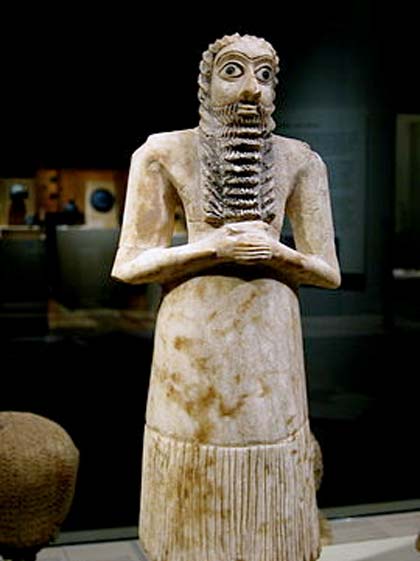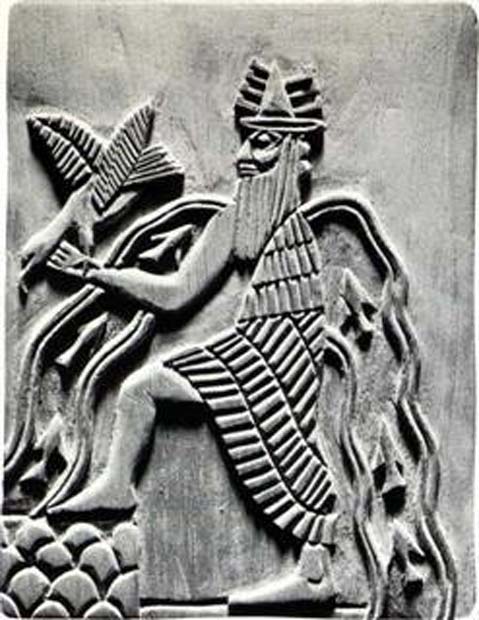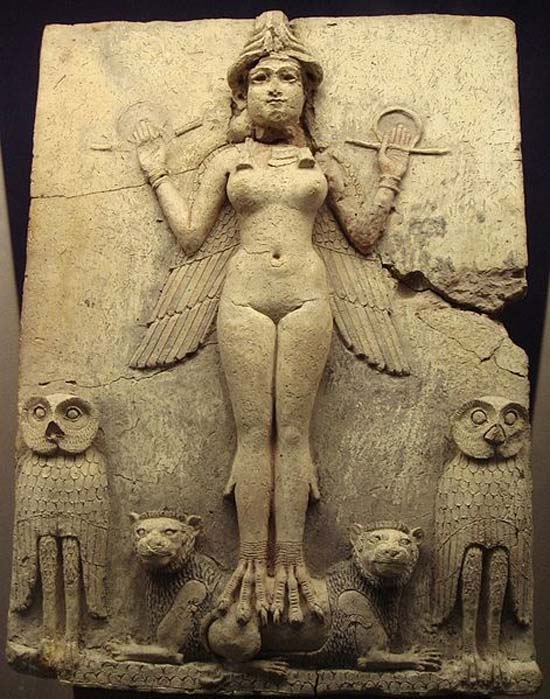
The Sumerian Seven: The Top-Ranking Gods in the Sumerian Pantheon
The Sumerian religion was polytheistic in nature, and the Sumerians worshipped a great number of deities. These deities were anthropomorphic beings, and were meant to represent the natural forces of the world. Some of these deities also had their counterparts in the religion of other Mesopotamian peoples. It has been estimated that the deities in Sumerian pantheon numbered in the hundreds or even in the thousands. Nevertheless, some gods and goddesses feature more significantly in the religion of Sumer, and thus may be considered to be the main deities of the Sumerian pantheon.

The Sumerian Pantheon. (Fredsvenn)
Sumer: A Cradle of Civilization
The Sumerians were the first known people to settle in Mesopotamia over 7,000 years ago. Located in the southernmost part of Mesopotamia between the Tigris and Euphrates rivers (modern day Iraq), Sumer was often called the cradle of civilization. By the 4 th millennium BC, it had established an advanced system writing, spectacular arts and architecture, astronomy and mathematics. The Akkadians would follow the Sumerians, borrowing from their culture, producing a new language of their own, and creating the world’s first empire.
The Sumerians were among the first known cultures to develop many benchmarks that are used to define a "civilization”. They are credited with the establishing codes of law, the plow, the sailboat, and a lunar calendar. They also developed a numerical system, based on the number 60 that is still used to measure seconds and minutes. However, probably the most famous legacy is their writing system. The Sumerians devised one of the earliest writing system known as cuneiform or wedge-shaped symbols. The tablets were then dried in the sun to preserve the text. Hundreds of thousands of these tablets have survived, providing a window into Sumerian culture, economy, law, literature, politics, and religion.
Located in what the ancient Greeks called Mesopotamia, meaning "the land between the rivers," Sumer was a collection of city-states or cites that were also independent nations, some of which endured for 3,000 years. Beginning around 3500 BC, the Sumerians began to build walled cities, including Ur, the capital of the civilization. Each of these cities contained public buildings, markets, workshops, and advanced water systems, and were surrounded by villages and land for agriculture. Political power originally belonged to the citizens, but as rivalry between the various city-states increased, each adopted the institution of kingship.
Each city-state was believed to be under the rule of a local god or goddess and their temples dominated the towns architecture. The Sumerians believed that their gods were responsible for all matters pertaining to the natural and social orders.

An artist’s illustration of Mesopotamia (Jeff Brown Graphics)
An: First Sumerian Lord of the Heavens
The most important god in the Sumerian pantheon is An (known also as Anu to the Akkadians). An was believed to be a sky god, and was initially regarded to be the Lord of the Heavens, or the supreme deity of the Sumerian pantheon. Later on, An’s leadership role was either shared or taken over by other gods. Nevertheless, he retained his importance, and continued to be revered. For example, when other deities rose to prominence, they are said to have received the anûtu (which may be translated as the ‘An power’), thus showing that An’s exalted status was maintained even though he had been replaced by another god as supreme deity.
- Leaving an Impression: Revealing the Intricate Story of Sumerian Cylinder Seals
- The origins of human beings according to ancient Sumerian texts
- The Sumerians: Their History, Culture, and Character

Sumerian male worshipper, 2750-2600 BC (CC BY-SA 2.0)
Enlil: Second Sumerian King of the Gods
Another main deity of the Sumerian pantheon was Enlil, an air god / god of wind and storms, who was the son of An and Ki. Enlil took over his father’s role as the king of the gods. In some Sumerian myths, Enlil has been depicted as a kind of creator god. His primary consort was Ninlil, goddess of the south wind, and Ninurta was the son of Enlil and Ninlil.
In the only Sumerian creation story known to have survived, Enlil is said to have separated his father and mother, thus marking the beginning of creation.
Enki: Sumerian creator of man
Enki was another important deity in the Sumerian pantheon. To the Akkadians and Babylonians, he was known as Ea. The Sumerians associated Enki with wisdom, magic and incantations, and was one of the three most powerful gods in the Sumerian pantheon, the other two being Ana and Enlil. Enki is credited with the creation of mankind, and was also, according to Sumerian mythology, its protector. It was Enki, for example, who warned Ziusudra about the flood that the gods intended to send to wipe out the human race. It may be due to his role as a protector god that Enki was quite a popular and beloved god amongst the Sumerians.

Image of the Sumerian god Enki. Modern reproduction of a detail of the Adda seal (c. 2300 BC) (Public Domain)
Inanna: A Sumerian national treasure
Based on the literary texts left behind by the Sumerians, it may be said that the most popular deity of the Sumerian pantheon was Inanna (known to the Assyrians and Babylonians as Ishtar). In many of the most famous and most often copied Sumerian stories, myths and hymns, one would find Inanna playing a prominent role. These include The Descent of Inanna, The Huluppu Tree, and Inanna and the God of Wisdom. It is from these texts that the nature of this goddess is known to us today. Inanna was worshipped as the goddess of sexuality, passion, love and war.
- Enheduanna: A High Priestess of the Moon and the First Known Author in the World
- New breath-taking ancient temple discovered in ancient Sumeria
- The Ishtar Gate and the Deities of Babylon

“Queen of the Night” relief. The depicted figure could be an aspect of the goddess Ishtar (Sumerian: Inanna) Mesopotamian goddess of sexual love and war. (Public Domain)
The Sumerian Seven
Apart from An, Enlil, Enki and Inanna, there were three other deities that make up the seven most important gods and goddesses of the Sumerian pantheon. One of them is Utu, a sun god and god of justice. At an early period of Sumerian history, Utu was regarded to be the twin brother of Inanna. Another important deity was Ninhursag, who was worshipped as a Mother Goddess. Therefore, she was associated with fertility, nature and life on earth. In addition, Ninhursag was the protectress of women and children, especially pregnant women and young children. The last of these seven important Sumerian deities is Nanna, the god of the moon and of wisdom. This god is sometimes considered to be the father of Inanna. His importance lies in the role he played during the act of creation.

Sumerian Chaos Monster and Sun God (Public Domain)
Top Image: Assyrian 8th century BC relief (Tony Baggett / Adobe Stock)
By Wu Mingren
References
faculty.gvsu.edu, 2017. Sumerian Myth. [Online]
Available at: http://faculty.gvsu.edu/websterm/SumerianMyth.htm
history-world.org, 2017. Sumerian Gods and Goddesses. [Online]
Available at: http://history-world.org/sumerian_gods_and_goddesses.htm
oracc.museum.upenn.edu, 2011. Ancient Mesopotamian Gods and Goddesses. [Online]
Available at: http://oracc.museum.upenn.edu/amgg/
Spar, I., 2009. Mesopotamian Deities. [Online]
Available at: http://www.metmuseum.org/toah/hd/deit/hd_deit.htm
www.mesopotamia.co.uk, 2017. Gods, Goddesses, Demons & Monsters. [Online]
Available at: http://www.mesopotamia.co.uk/gods/explore/main.html
















Comments
Enlil, An and Enki always seemed to vie for kingship within the stories (unspokenly). An was one of the first, Enlil one of the most powerful and Enki one of the smartest. No wonder the Babylonians would later claim that their national god Marduk was the son of Enki (and the head of the pantheon) and An would trick Enki (Ea's) favourite mortal Adapa into a mortal life barring him from a chance of immortality